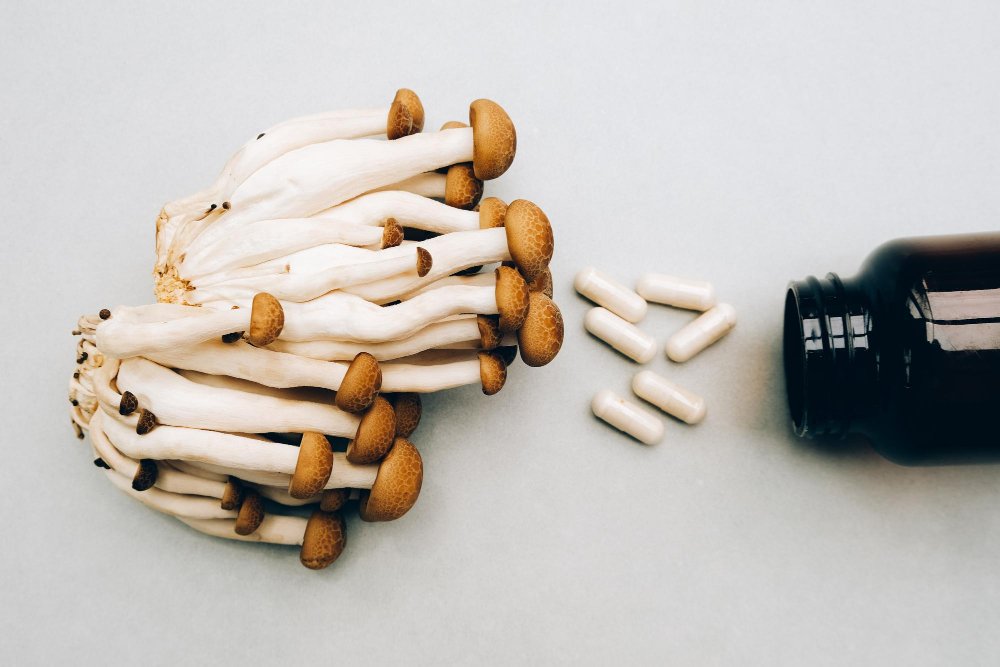As hobby mycologists we tend to gush about all fungi, but a handful of species earn the label “functional mushrooms” because their fruit‑bodies or mycelia supply bioactive compounds—β‑glucans, terpenoids, ergothioneine, cordycepin—that go beyond basic nutrition. The clinical literature is still emerging, yet several lines of evidence already hint at real‑world utility.
1. Lion’s Mane (Hericium erinaceus) – Cognitive Support
Randomised trials in older adults with mild cognitive impairment found that 3 g day‑1 of dried fruit‑body for 16 weeks improved Mini‑Mental State Examination scores; the benefit faded after supplementation stopped, suggesting a use‑it‑or‑lose‑it effect.[1] Parallel work in younger adults reports faster processing speed and lower perceived stress, though sample sizes remain small.[2] Proposed mechanism: hericenones / erinacines stimulating nerve‑growth factor (NGF) synthesis.
2. Reishi (Ganoderma lucidum) – Immune Modulation & Fatigue Relief
Polysaccharide‑rich extracts appear to prime natural‑killer and dendritic cells while damping pro‑inflammatory cytokines. A recent symptom survey of long‑term users listed reduced fatigue and better appetite as the most consistent subjective benefits.[3] Clinical endpoints (e.g., infection rates) still need well‑powered trials, but the safety profile is excellent.
3. Cordyceps (C. militaris, C. sinensis) – Endurance & Energy
A three‑week placebo‑controlled study in recreational athletes showed cordyceps extract (1.5 g blend/day) extended time‑to‑exhaustion by ~70 s and raised VO2 max ~5 %.[4] Fresh 2025 animal work also links cordycepin to reduced exercise‑induced memory fatigue.[5] Translation to elite sport is unproven, but for weekend cyclists it may provide a small aerobic edge.
4. Turkey Tail (Trametes versicolor) – Adjunct in Oncology
Polysaccharopeptide (PSP) and polysaccharide‑K (PSK) extracts have decades of use in Japanese oncology. A U.S. pilot trial found breast‑cancer patients regained post‑radiation NK‑cell activity faster when taking 6–9 g day‑1 pulverised fruit‑body.[6] Meta‑analyses suggest fewer chemo‑related side‑effects, though survival data remain inconclusive.
5. Chaga (Inonotus obliquus) – Antioxidant & Anti‑Inflammatory Potential
High phenolic content gives chaga one of the strongest ORAC values in the fungal kingdom. In vitro, chaga extracts dose‑dependently cut IL‑6 and TNF‑α release in LPS‑stimulated macrophages.[7] Human data are minimal, so at present its role is best framed as a potent antioxidant tea rather than a proven therapeutic.
Practical Caveats
- Product Quality – Look for third‑party lab verification of β‑glucan content; many “mushroom” capsules are mostly grain substrate.
- Dosage & Duration – Trials that showed benefit generally used ≥ 1–3 g dried fruit‑body (or 300–500 mg concentrated extract) daily for at least 4 weeks.
- Drug Interactions – Reishi and turkey tail may alter anticoagulant or immunosuppressant efficacy; immunocompromised individuals should check with a clinician.
- Regulatory Status – In the U.S., functional mushroom supplements are foods, not drugs; claims are not FDA‑evaluated.
Bottom Line
While not magic bullets, functional mushrooms provide intriguing, low‑risk bioactive compounds that support cognition, immune balance, endurance, and oxidative‑stress management. The strongest human evidence today sits with lion’s mane for mild cognitive decline, cordyceps for modest endurance gains, and turkey tail as an immune‑restorative adjunct during cancer therapy. Ongoing randomised trials will clarify optimal dosing and long‑term safety—but for curious fungi fans, a daily gram or two of well‑sourced extract is a reasonable, evidence‑aligned experiment.
References
- Morimoto H et al. Phytotherapy Research. 2023;37(9):4573‑4582.
- Lee S‑J & Noh J‑H. Nutrients. 2024;16(2):312.
- Zhao Y et al. Journal of Ethnopharmacology. 2022;298:115671.
- Escudero J et al. Journal of Dietary Supplements. 2021;18(5):502‑516.
- Wang Y‑C et al. Frontiers in Physiology. 2025;16:118922.
- Standish LJ et al. ISRN Oncology. 2022;2022:932165.
- Kim H‑S et al. International Journal of Molecular Sciences. 2025;26(4):1897.

